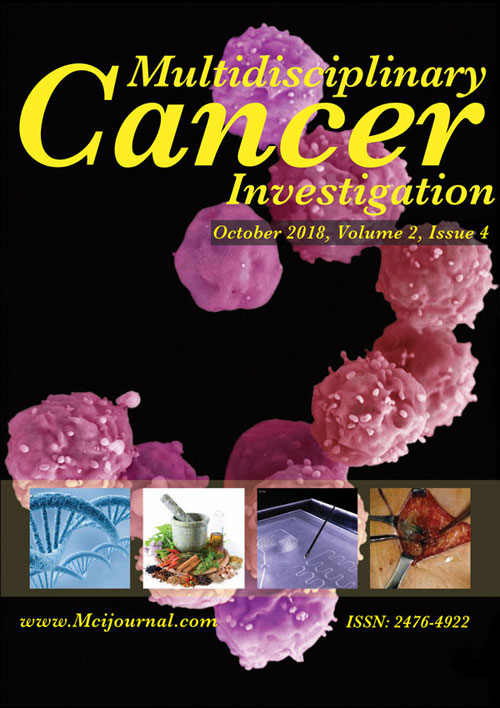فهرست مطالب

Multidisciplinary Cancer Investigation
Volume:2 Issue: 4, Oct 2018
- تاریخ انتشار: 1397/10/09
- تعداد عناوین: 3
-
-
Pages 5-15DNA sequencing is one of the great valuable techniques in molecular biology, which can be used to detect the sequence of nucleotides in a DNA fragment. The high-throughput se quencing known as Next Generation Sequencing (NGS) revolutionized genomic research and molecular biology; therefore, the whole human genome can be sequenced with a low cost in several days. NGS technology is similar to the traditional method, Sanger, which detects small DNA fragments by emitted signals at the time of synthesis of each fragment (from the DNA template), but the difference is that NGS can determine the massive simul taneous sequencing in a few days with high accuracy and the results are directly detected without the need for electrophoresis. In fact, NGS technology combines a variety of steps such as sample preparation, fragmentation of the sample of the studied genome, attachment of adapter to the ends of the fragments, imaging, and data analyses. In recent years, NGS technology continuously expanded the range of applications in different fields by reducing costs, increasing rates, and improving the quality of the data. The current review provid ed the potential applications of the NGS technology by emphasizing the diagnosis of the genetic diseases, identification of several types of cancers, prenatal screening, epigenetic modifications, personalized medicine, and identification of pathogens.Keywords: High-Throughput Nucleotide, Sequencing Whole Genome, Sequencing Whole Exome, Sequencing Clinical, Application
-
Pages 16-24IntroductionBovine leukemia virus (BLV) causes enzootic bovine leukemia, andis closely related to human T-lymphotropic virus type 1. It expresses microRNAs of unknown function and codes Tax, the protein that mediates malignant transformation. BLV is capable of infecting B- and T-lymphocytes, endothelial cells, and mammary epithelial cells of cattle. Several studies demonstrated the presence of BLV DNA in human tissue, and it is significantly associated with breast cancer in case-control studies using in situ PCR, a highly sensitive and specific technique. The current study was the first report of BLV DNA detection by in situ PCR in tissue from Argentinian females with a diagnosis of breast cancer.MethodsIn situ PCR was done to detect BLV DNA in 85 human FFPE breast cancer tissue samples. The association of BLV DNA and expression of Ki67 and Her-2 was assessed.ResultsBLV DNA presence could be determined in 22.6% of the analyzed samples, and its presence was associated with an increase of the expression and prognosis markers Ki67 (P=0.009) and HER-2 (P=0.044) determined by conventional immunohistochemistry. No statistical significance was observed between the presence or absence of hormonal receptors and the presence of BLV DNA.ConclusionsThe obtained results support the idea that BLV might play a role in malignant tissue transformation.Keywords: Leukemia Virus, Bovine, Human Breast Cancer, Direct In Situ PCR, Cell Proliferation, Prognosis
-
Pages 25-29IntroductionNon-melanoma scalp skin cancers (NMSCs) including squamous cell carcinomas (SCCs) and basal cell carcinomas (BCCs) are common. To manage such cancers, especially SCCs, more attention should be paid to their invasive characteristics. Mortality surveillance of SCCs and BCCs of scalp helps to choose proper approaches.MethodsThe current retrospective, descriptive study was conducted on 723 patients with NMSCs of scalp according to their epidemiologic and clinical manifestations. Invasive extended tumor (IET) are defined as aggressive SCCs and BCCs, which affect survival of patients. Therapies categorized in patients, and all the gathered data were analyzed.ResultsThe 723 patients including 228 SCCs and 495 BCCs were evaluated in two compatible groups. Lymphatic metastasis, IET, and higher stages in SCCs were significant (P <0.005). Mean and 95% confidence intervals (CI) for SCCs and BCCs survival were 6.97 years (6.7-7.25) and 7.6 years (7.46-7.73), respectively, with significant difference between the groups (P=0.001); risk of mortality enhanced 2.05 and 22.07 times in SCC and IET clinical manifestation, respectively. Mean and 95% CI for recurrence time among SCCs and BCCs were 1.74 (1.26-1.75) and 2.26 (1.63-2.37) respectively, and there was a significant difference between the groups (P=0.001).ConclusionsThe current retrospective study showed that BCC frequency was twice more than that of SCC without significant dominancy on gender or age in scalp area with significant number of IET cases in SCCs. Mortality risks enhanced 2.05 times in SCCs and risk of recurrence increased 1.85 times in BCCs. These knowledge can guide to employ a proper approach.Keywords: Carcinoma, Basal Cell, Squamous Cell, Survival, Recurrence, Invasive Tumor

